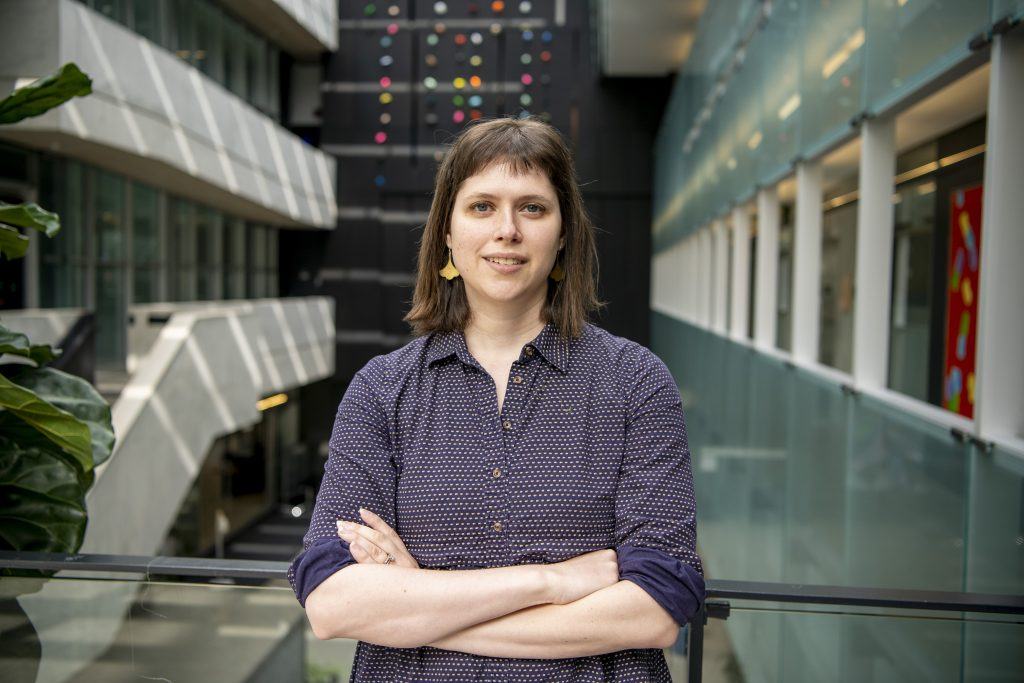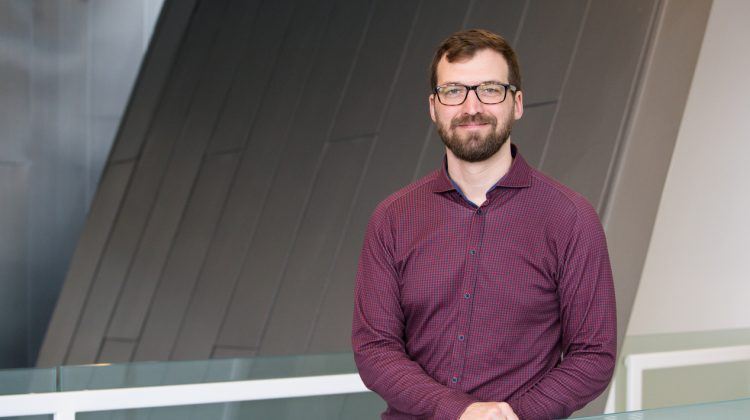“Fuzzy sphere” technique sharpens understanding of phase transitions
A new method brings physicists closer to resolving 50-year-old conjecture.

Phase transitions occur all over the natural world. Some are familiar, like ice melting to water. Others are more obscure, like the emergence of superconductivity in supercooled metals, or iron’s sudden loss of magnetism when heated to 770°C.
Something fundamental about the physics of our universe might hide beneath these seemingly unrelated transitions: all phase changes seem to share a deep symmetry known as “conformal invariance.”
For more than five decades, this connection has been just conjecture. This year, in an exciting step forward, a paper published in Physical Review X outlines a new method of studying that symmetry.
“It is the most exciting work I have ever done. This result is really amazing,” says Yin-Chen He, a research faculty member at Perimeter Institute. “Our approach has allowed us to access a lot of new information that wasn’t possible with other methods.”
He and his colleagues mapped phase transition data onto a sphere using non-commutative coordinates. Their “fuzzy sphere” technique offers more clarity about conformal symmetry than previous methods, with a remarkably simple model. The implications could be groundbreaking.
Understanding conformal symmetry
The study of phase transitions goes back nearly two centuries. A major advance came in the 1920s, when German physicists created a model of how ferromagnetism (the magnetic behaviour of iron and similar metals) works on a microscopic level. Named for Ernst Ising, one of its developers, the Ising model works by considering the “spin” – or magnetic moment – of individual electrons within a material.
The Ising model uses a graph-paper-like grid lattice to represent the material. Every point where the grid lines intersect represents an electron with a different spin. Each electron can affect only its nearest neighbours.
At high temperatures, the electrons’ spins will act randomly with no discernible patterns. But below a critical temperature, a phase change occurs: the electrons start aligning themselves, one neighbour at a time, until the whole material is magnetized. The system goes from a disordered state to an ordered one seemingly spontaneously.
At the critical point, something else surprising happens. The pattern of behaviour displayed by each electron and its neighbours looks the same no matter how much you zoom in and out – the patterns seen across a few dozen electrons look the same as across a million of them. This is a kind of symmetry known as “scale invariance.” Scale invariance is emergent, a property that only exists when looking at many particles acting together, rather than at individual particles. It emerges only at the point of phase change, not before or after.
Physicists suspect there is an even deeper symmetry at work here that includes scale invariance but has several additional features. This special conformal symmetry, as it’s called, preserves angles but not necessarily distance. It is a fundamental property of some quantum field theories – aptly named conformal field theories – which are of interest not just to condensed matter physicists like He but also to high energy physicists working on string theories or quantum gravity and so on.
Conformal symmetry emerges at the critical point in two-dimensional Ising models but remains conjectural in three dimensions.
Working with a fuzzy sphere
Part of physicists’ fascination with phase transitions is that very disparate phenomena seem to share identical properties, connecting freezing, melting, magnetism, and superconductivity.
All phase transitions, for example, have “critical exponents” – universal numbers that characterize the transitions.
A grid-like lattice can be used to calculate critical exponents: by making the lattice bigger and bigger (something called finite size scaling), physicists can eventually produce these universal numbers.
But it would be very useful to have a different, independent way to calculate critical exponents. Enter the fuzzy sphere method.

“Putting it on a sphere is a way to test if you really have a conformal field theory,” says Emilie Huffman, a postdoctoral researcher at Perimeter Institute and a co-author on the paper. “You can check to see if these universal numbers match when you measure them one way versus the other way.”
But adapting a grid-like coordinate system to a sphere is no simple task.
“It’s like taking graph paper and trying to fit it over a tennis ball or something like that. It’s really hard to make it work,” Huffman says.
The researchers needed a workaround to sidestep the defects of applying a rectangular lattice (or even a 3D cubic one) to a spherical shape.
The solution they came up with was to set aside spacetime coordinates. Instead of imagining each particle having a set point in space, they allow the particles’ positions to only loosely be defined – indeed, their exact positions are now unknowable. Instead, you have a sort of probability distribution of where each particle is likely to be on the sphere. In this scenario, the coordinates of each particle become “non-commutative.”
If something is commutative, that means the order of operations doesn’t matter. Changing the order doesn’t change the outcome: 1+2 equals 2+1.
If something is non-commutative, order matters. Consider rotating a book: first along the x axis, then the y. Start again with the opposite order: rotate along y, then x. The book will end up in a different position. The order of rotations changes the outcome, so this process is non-commutative.
On a sphere with non-commutative coordinates, you can never know exactly where a particle is on the sphere, because it changes depending on how you measure it – the coordinates are a little “fuzzy”.
Of course, this makes any sort of definitive calculations using the particles’ positions impossible, so the team needed to give the particles a different well-defined property to work with. By considering a magnetic field encompassing the sphere, the team were able to ensure that each particle had a defined angular momentum. With that alternative knowable property in place, the computer simulations still have discrete numbers to work with.
“It’s a bit like a quantum version of geometry,” says He. “It reminds you about the uncertainty principle of quantum mechanics, in which the x coordinates (the position) and the momentum are non-commuting. This idea goes one step further, in which even your space is not commuting.”
The uncertainty principle describes how learning more information about one property of a quantum particle, like its momentum, limits what you can know about another property, like its position. A similar thing occurs on the fuzzy sphere – the angular momentums are well defined, but the trade-off is that you lose clarity about the exact coordinates of each particle.
The bright side of the trade-off is that the defects caused by putting a spacetime lattice on a sphere can be bypassed. The consequences of that trade-off have been astounding.
What they found (and what it might mean)
The team have been surprised by how successful their new method has proven to be at producing critical exponents that align with those produced via the lattice method.
“The miraculous thing is that it works great,” says He. “In the past, when people simulated Ising transitions using lattice models, they needed to simulate huge system sizes. Typically, you need to go as high as thousands or millions of spins, and even then you only get a limited amount of information. But in our case, around 16 spins can give us a pretty accurate result, and give much more information than those traditional lattice simulations of millions of spins. That’s really important. That’s why this result is really amazing.”
Smaller systems make the new technique less computationally intensive, though He acknowledges some loss of accuracy. Still, their approach provides a powerful new tool for examining conformal symmetry in phase transitions.
“It should not work that well,” He says. “I guess there’s something very fundamental hidden there. There may be some deep connections between this non-commutative geometry, phase transitions, and conformal field theories.”
One significant and long-standing challenge for the physics community has been to define and regularize quantum field theories. Using non-commutative geometry to do so is one of several directions people have pursued in the past.
“It’s been unclear whether that’s really the right way to go,” says He. “But now, with our results, I think it’s a good time to really revisit this. Maybe this missing piece is secretly hidden in our approach, although I don’t know precisely what it is.”
The fuzzy sphere method might be key to proving conformal symmetry in the 3D Ising model and to unlocking a broader mathematical scheme for quantum field theories. He and his colleagues are cautious but can’t help getting excited by what they’re seeing.
“Maybe our model is defined using the right basis, such that it’s very close to the final result. That’s my intuition. It would explain why it works so well,” says He. “It might eventually guide us to finding the exact solution that people are looking for. Then again, maybe it’s just a fantasy! I think they’re all long shots, but the possibilities are exciting!”
Read the paper:
Wei Zhu, Chao Han, Emilie Huffman, Johannes S. Hofmann, and Yin-Chen He, “Uncovering Conformal Symmetry in the 3D Ising Transition: State-Operator Correspondence from a Quantum Fuzzy Sphere Regularization,” Phys. Rev. X 13 (2023) 021009.

























































































